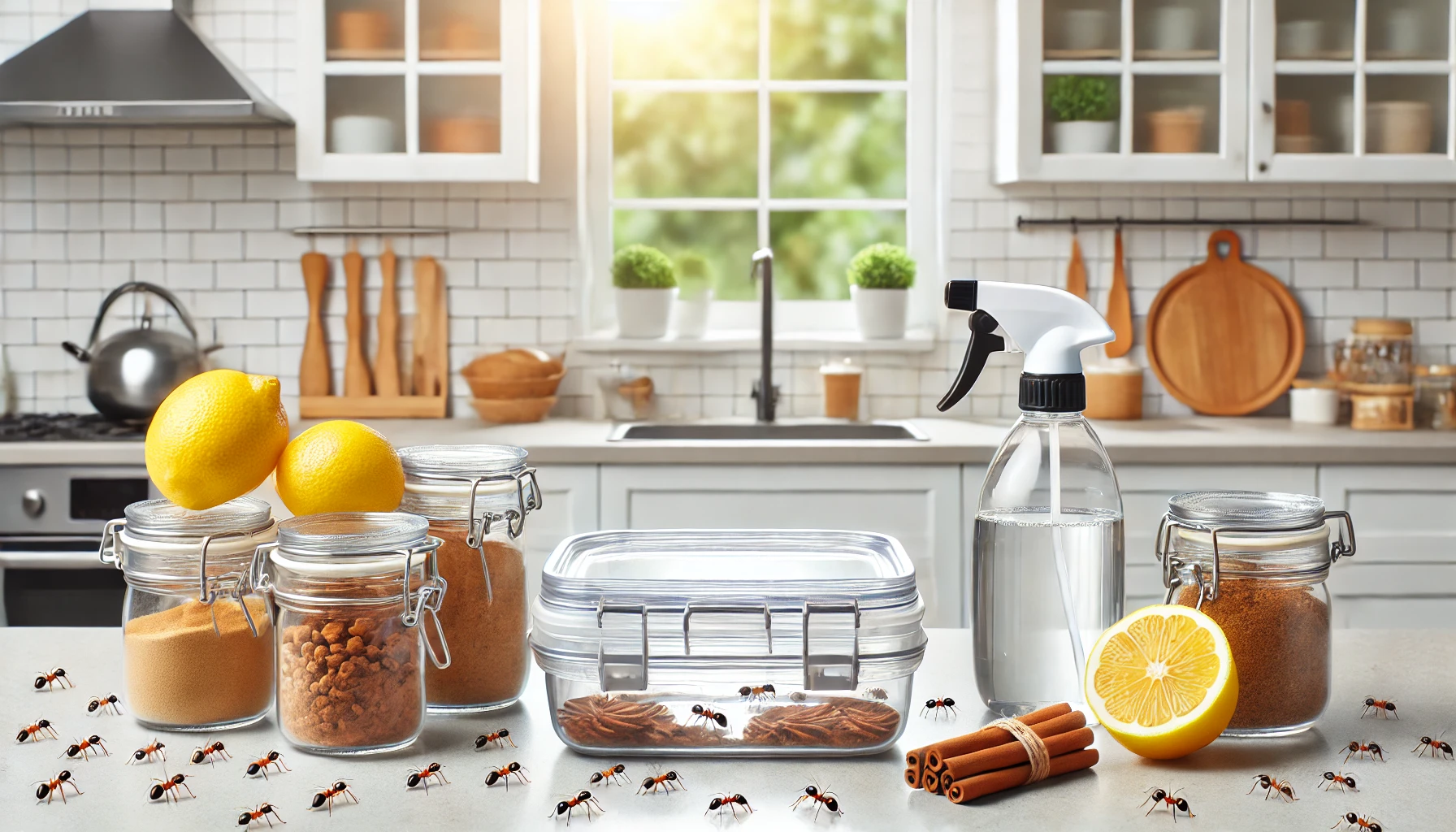Introduction
Sugar ants are a common household nuisance, especially in kitchens where they search for food. These tiny invaders are particularly attracted to sweets, crumbs, and food residue, making it essential to address infestations promptly. If left untreated, sugar ants can quickly multiply, creating large colonies that are difficult to eliminate.
In this guide, we will take you through a step-by-step process to effectively get rid of sugar ants in your kitchen. From identifying their entry points to sealing them off and using natural and chemical solutions, this article will help you maintain an ant-free kitchen.
What Are Sugar Ants?
Sugar ants, scientifically known as Camponotus consobrinus, are tiny insects commonly found in homes. While they are called “sugar ants,” this term often refers to various small ants that are drawn to sweet substances. Some common species include odorous house ants, pharaoh ants, and pavement ants.
These ants are harmless to humans but can be a serious annoyance. They invade kitchens in search of food and leave scent trails for other ants to follow. Unlike other pests, sugar ants do not bite or sting, but their presence indicates a hygiene issue that should be addressed quickly.
Why Do Sugar Ants Invade Kitchens?
Sugar ants invade kitchens primarily because they are attracted to food sources. They have an incredibly strong sense of smell and can detect sugar, syrup, and other food residues from a distance. Here are a few common reasons why these ants may appear in your kitchen:
- Unsealed food – Open containers of sugar, honey, or bread crumbs can attract ants.
- Spilled liquids – Soda, juice, and coffee spills can be a major attraction.
- Pet food – If pet food is left out, sugar ants will take advantage of it.
- Garbage bins – Overflowing trash cans with food scraps invite ant infestations.
Are Sugar Ants Harmful?
While sugar ants are not directly harmful to humans, they can contaminate food and surfaces. Here are some potential risks:
- Food Contamination: Sugar ants crawl over unsealed food, potentially carrying bacteria from garbage or dirty areas.
- Hygiene Concerns: Large infestations can create an unsanitary kitchen environment.
- Difficult to Remove: If not addressed properly, sugar ants can establish long-term colonies within your home.
Step 1: Identify the Source of the Infestation
The first step in eliminating sugar ants is to identify where they are coming from. This involves tracking their movement, locating entry points, and determining what is attracting them.
How to Spot Sugar Ant Trails
Sugar ants leave behind invisible pheromone trails that guide other ants to the food source. These trails are usually found along countertops, walls, and floors. To track them:
- Observe where the ants are moving.
- Follow their trail back to the entry point.
- Look for signs of a nearby nest if possible.
Common Entry Points (Doors, Windows, Cracks, Pipes, etc.)
Sugar ants enter homes through tiny cracks, gaps in windows, doors, and plumbing pipes. Check the following areas:
- Window frames – Small gaps allow ants to slip through.
- Kitchen sink drains – Ants are drawn to water sources.
- Gaps in cabinets and floors – Hidden spaces are ideal entry points.
What Attracts Sugar Ants? (Food Crumbs, Spilled Sugar, Pet Food)
The main reason sugar ants invade is the availability of food. Here’s what attracts them the most:
- Leftover crumbs on floors and countertops.
- Spilled sugar from baking or drinks.
- Pet food bowls left out overnight.
Step 2: Clean and Eliminate Food Sources
Once you have identified their food source, thoroughly clean your kitchen to remove anything that attracts sugar ants.
Proper Food Storage (Sealed Containers, Airtight Jars)
One of the best ways to deter ants is by storing food in airtight containers. Make sure:
- Sugar, flour, and cereals are in sealed jars.
- Snacks and chips are kept in ziplock bags.
- Fruits are stored in the fridge instead of the counter.
Cleaning Surfaces and Floors Regularly
A daily cleaning routine prevents sugar ants from finding food. Essential tips:
- Wipe down countertops after cooking.
- Sweep and mop floors daily.
- Disinfect trash bins to remove odors.
Taking Out the Trash Frequently
Garbage attracts ants, so empty trash cans daily. Also:
- Use trash bags that seal properly.
- Clean the inside of bins every week.
- Avoid letting garbage overflow.
Managing Pet Food and Water Bowls
Pet food is another major attraction for sugar ants. To prevent infestations:
- Keep pet food bowls elevated or on a tray.
- Remove uneaten food after mealtime.
- Clean around pet feeding areas daily.
Read More: how much does it cost to paint kitchen cabinets
Step 3: Seal Entry Points and Prevent Future Infestations
Blocking the ants’ entry is critical in keeping them out.
Identifying and Sealing Cracks and Gaps
Find and seal any small gaps where ants might be entering. Use:
- Caulk or silicone sealant to close cracks.
- Steel wool to block small holes.
- Weather stripping to seal gaps in doors and windows.
Using Weather Stripping on Doors and Windows
Install weather stripping around doors and windows to prevent ants from sneaking in. This is especially important in:
- Kitchen entry doors.
- Windows above countertops.
- Any gaps around sliding glass doors.
Fixing Leaky Pipes and Reducing Moisture
Ants are attracted to moisture. To keep them away:
- Repair leaky pipes under sinks.
- Ensure proper ventilation in the kitchen.
- Wipe down wet surfaces after washing dishes.
Step 4: Use Natural Remedies to Repel Sugar Ants
Natural remedies are an effective and safe way to repel sugar ants without using harmful chemicals.
Vinegar and Water Solution
Vinegar is a natural ant repellent because its strong scent disrupts their pheromone trails. Here’s how to use it:
- Mix equal parts of white vinegar and water in a spray bottle.
- Spray it along countertops, entry points, and areas where ants are seen.
- Wipe surfaces with a clean cloth to remove any remaining scent trails.
- Repeat this process daily for best results.
Lemon Juice and Citrus Peels
Lemon juice contains citric acid, which masks ant trails and deters them. To use:
- Squeeze fresh lemon juice along windowsills, doorways, and cracks.
- Place citrus peels in areas where ants commonly enter.
- Refresh the lemon juice and peels every few days to maintain effectiveness.
Baking Soda and Powdered Sugar Trap
Baking soda disrupts ants’ digestive systems, and when mixed with sugar, it attracts them. Here’s how to make a DIY ant killer:
- Mix equal parts of baking soda and powdered sugar.
- Place small amounts near ant trails and entry points.
- The sugar lures the ants, and the baking soda kills them once ingested.
Coffee Grounds and Cinnamon as Natural Barriers
Both coffee grounds and cinnamon work as natural ant repellents due to their strong scent.
- Sprinkle coffee grounds near windows, doors, and along baseboards.
- Use cinnamon powder in cracks and other entry points.
- Replace these barriers once a week for continued effectiveness.
Step 5: Deploy Ant Baits and Traps for Effective Elimination
If natural remedies are not enough, using ant baits and traps can help eliminate sugar ants from your kitchen.
How Ant Baits Work (Slow-Kill Method)
Ant baits contain a sweet substance mixed with a slow-acting poison. When ants take the bait back to their colony, it spreads and eliminates the entire nest.
- Place ant bait stations near ant trails and entry points.
- Avoid spraying insecticide near baits, as it prevents ants from taking the bait.
- Be patient – baits take several days to kill the colony.
Best Ant Bait Products to Use
Some of the most effective sugar ant baits include:
- Terro Liquid Ant Baits – Popular and highly effective.
- Raid Ant Baits – Comes in small containers to place around the kitchen.
- Combat Max Ant Killing Gel – A gel bait that ants carry back to their nest.
DIY Borax and Sugar Bait Recipe
For a homemade solution:
- Mix 1 tablespoon of borax with 3 tablespoons of powdered sugar.
- Add a few drops of water to form a paste.
- Place small amounts near ant trails.
- Monitor and refresh the bait every few days.
Read More: how to paint kitchen cabinets without sanding
Step 6: Try Chemical Solutions for Severe Infestations
If the infestation persists despite natural remedies and bait traps, chemical treatments may be necessary.
Ant Sprays and Insecticides
Ant sprays provide immediate results but should be used cautiously in the kitchen. The best options include:
- Raid Ant & Roach Spray – Kills on contact but does not address the colony.
- Ortho Home Defense Insect Killer – Provides long-lasting protection.
- Eco Defense Organic Home Pest Control – A safer, non-toxic spray option.
Professional-Grade Ant Killers
For severe infestations, stronger chemical solutions like Termidor SC or Advion Ant Gel may be needed. These require careful application and should be kept away from food areas.
Are Chemical Treatments Safe for Pets and Kids?
If you have pets or small children, choose products labeled pet-safe or use traps placed out of reach. Consider natural repellents as a first line of defense before resorting to chemicals.
Step 7: Call a Professional Pest Control Service (If Necessary)
If home remedies and store-bought solutions fail, professional exterminators can help eliminate sugar ants effectively.
When to Seek Professional Help
Consider hiring a pest control service if:
- The infestation persists for more than a month.
- Ants keep returning despite multiple treatments.
- You find multiple ant colonies or large nests inside walls.
What to Expect from an Exterminator
A pest control expert will:
- Inspect your kitchen to find entry points and nests.
- Use advanced baiting systems and professional-grade insecticides.
- Provide long-term prevention strategies to keep ants away.
Cost of Professional Ant Removal
Professional extermination costs vary depending on the severity of the infestation. On average:
- Basic ant treatment: $150 – $300
- Severe infestations: $500+ for multiple treatments
Step 8: Maintain a Long-Term Prevention Strategy
Preventing future sugar ant infestations requires consistent kitchen hygiene and preventative measures.
Regular Kitchen Cleaning Routine
To keep ants away, maintain a strict cleaning schedule:
- Sweep and mop daily to remove food crumbs.
- Disinfect countertops and cabinets after meals.
- Store food properly in sealed containers.
Using Essential Oils as Natural Repellents
Certain essential oils have ant-repellent properties. To keep ants away:
- Mix peppermint, tea tree, or eucalyptus oil with water.
- Spray along baseboards, windows, and entry points.
- Refresh every few days to maintain effectiveness.
Seasonal Ant Prevention Tips
Ant infestations are more common in warm weather. During summer and spring:
- Check windows and doors for new cracks or gaps.
- Avoid leaving sugary drinks or food unattended.
- Keep outdoor garbage bins sealed tightly.
Conclusion
Recap of Key Steps to Eliminate Sugar Ants
To successfully get rid of sugar ants in your kitchen:
- Identify the source of infestation – Find entry points and food sources.
- Eliminate food sources – Clean regularly and store food properly.
- Seal cracks and gaps – Prevent ants from entering.
- Use natural remedies – Try vinegar, lemon juice, or baking soda.
- Set ant baits and traps – Use borax, sugar, or commercial products.
- Use chemical treatments (if needed) – Apply sprays or insecticides safely.
- Call a professional if necessary – If all else fails, hire an exterminator.
- Maintain a long-term prevention strategy – Keep your kitchen clean and use repellents.
Encouragement to Stay Consistent with Prevention
Sugar ants are persistent, but regular maintenance and preventive measures can keep them away permanently.
Final Thoughts on Keeping a Pest-Free Kitchen
By following these steps, you can eliminate sugar ants from your kitchen and prevent future infestations. Remember, the key to long-term success is consistent cleaning, sealing entry points, and using repellents when necessary.

